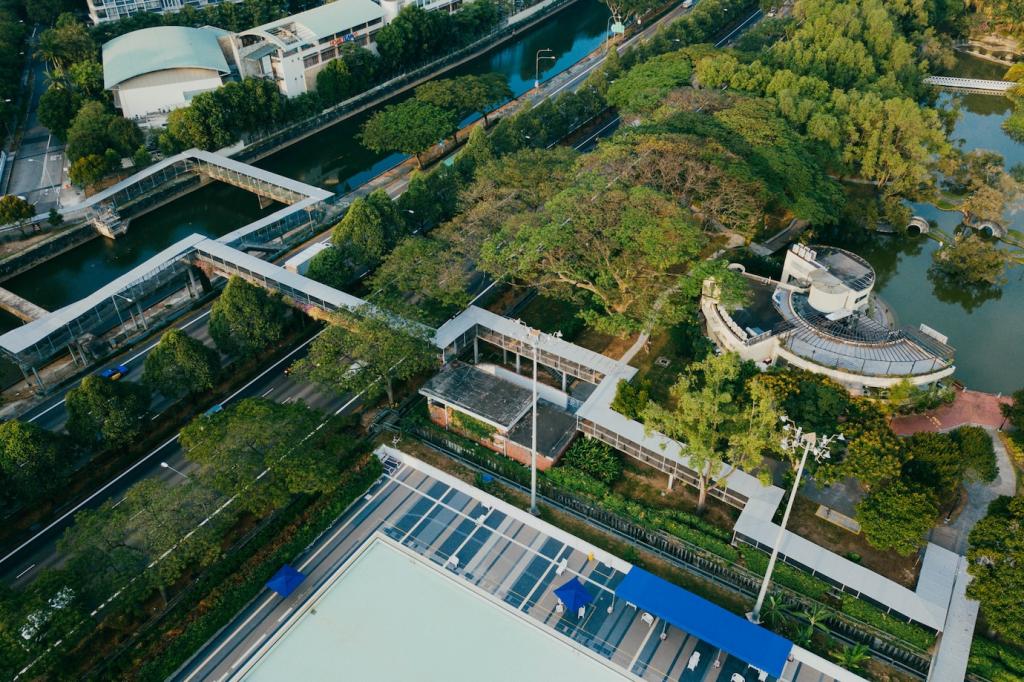Cutting-Edge Approaches in Green Building Design
Cutting-edge green building design is transforming the built environment by integrating sustainability, innovation, and functionality. Today, architects, engineers, and developers are pushing beyond traditional energy-saving methods, exploring advanced technologies and mindful design strategies to reduce carbon footprints while enhancing occupant wellbeing. This page explores some of the most progressive and effective approaches shaping the future of eco-friendly construction and sustainable architecture.

Previous slide
Next slide

Innovative Materials and Construction Methods
Materials such as bamboo, cross-laminated timber, mycelium composites, and recycled steel are increasingly popular for their low embodied energy and environmental impact. The use of agricultural byproducts, reclaimed wood, or recycled plastics reduces dependency on virgin resources and cuts carbon emissions associated with extraction and manufacturing. These bio-based materials offer durability, aesthetic flexibility, and can contribute positively to a structure’s life cycle assessment.
Off-site manufacturing of building components under controlled conditions allows for precision, waste reduction, and efficient resource use. Modular and prefabricated systems can be quickly assembled on-site, lessening disruptions to the local environment and shortening construction times. This method also supports quality assurance and enables tighter integration of insulation, waterproofing, and mechanical systems for higher overall building performance.
Traditional concrete is a major source of global carbon emissions. Innovations such as geopolymer concrete, carbon-cured concrete, and aggregates from recycled materials address this problem. By substituting Portland cement with fly ash or slag, and employing advanced curing methods, builders achieve comparable structural strength while drastically lowering the carbon footprint. These next-generation concretes also offer enhanced durability and resilience against weather extremes.

Smart Technologies and Building Automation
Building Management Systems (BMS)
Advanced Building Management Systems connect heating, ventilation, lighting, and security to a central hub that dynamically adjusts settings based on occupancy, weather patterns, and energy availability. By continuously monitoring conditions, a BMS can minimize waste, maintain comfort, and provide actionable insights to facility managers. This holistic coordination results in significant energy savings and prolongs equipment lifespan.
Adaptive Lighting and Shading
Smart lighting systems use sensors to adjust brightness and color temperature according to daylight availability and occupant presence. Automated shading devices respond to the sun’s movement, optimizing comfort while preventing glare and overheating. These responsive technologies not only enhance user comfort but also significantly drive down energy consumption for lighting and climate control.
Internet of Things (IoT) Integration
IoT networks connect various building components and appliances, offering granular monitoring and control. From air quality sensors to intelligent thermostats and occupancy counters, IoT integration empowers detailed management of energy and water use. Real-time analytics support predictive maintenance and promote the highest standards of sustainability and indoor environmental quality.
Integrating collection and storage systems for rainwater offers onsite alternatives to potable water for irrigation, flushing toilets, and other non-potable uses. Designs incorporate roof catchments, filtration, and storage tanks that work seamlessly with existing plumbing. Capturing rainwater helps mitigate runoff, decreases dependence on municipal supplies, and fosters resilience in drought-prone regions.
Water Conservation and Management
Previous
Next
Renewable Energy Integration
Solar panels can be seamlessly integrated into rooftops, facades, and building elements, converting sunlight directly into electricity. Advances in panel efficiency and mounting systems now allow for flexible design and greater energy capture even in less sunny climates. Coupled with battery storage, photovoltaics enable buildings to produce their own power, limit grid dependence, and support peak load management.
Previous slide
Next slide

Previous slide
Next slide
